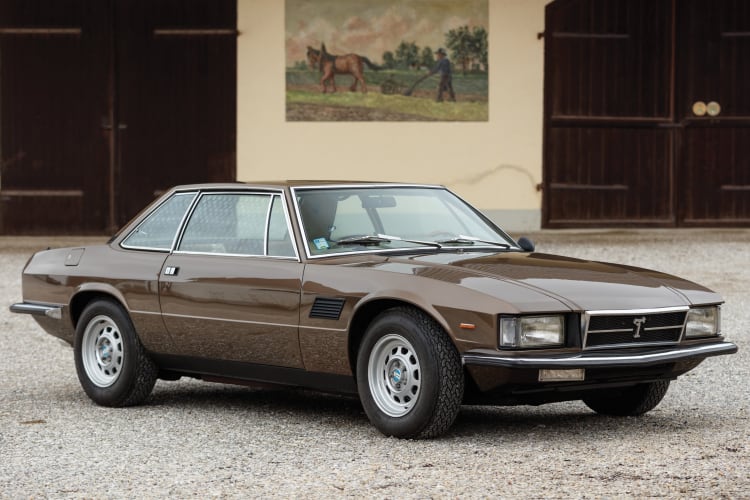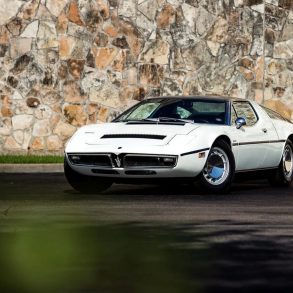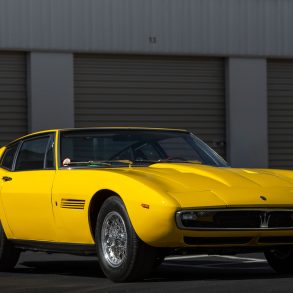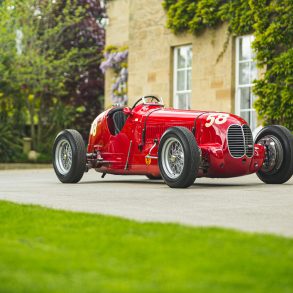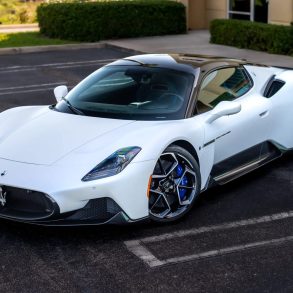First, let’s clarify a few definitions:
- Hybrid: a person [or thing] produced by the blending of two diverse cultures or traditions
- Half-breed: having one purebred parent
- Alessandro De Tomaso: Automotive Magician who could develop cars out of thin air with practically no budget
The first two definitions came from Webster’s. The third most definitely did not, but you’ll soon see why it’s appropriate.
Argentine ex-pat DeTomaso had much more in mind from his business marriage with Ford than just the Pantera. He envisioned a full line of high-performance exotica that would unfold throughout the early 1970s.
On the drawing board at approximately the same time was the four-door Deauville, a luxury sedan looking not at all unlike a first-gen XJ-6 and the Zonda.

This front-engine coupe would have been DeTomaso’s version of something like the Maserati Ghibli. A third car was the Longchamp: a square-shouldered two-door, four-place coupe that one automotive journalist described as a “Mercedes 450 SLC on steroids.”
The Deauville went into production in 1972, with the Longchamp following about a year later. The Zonda remained yet another unbuilt De Tomaso prototype.
Tom Tjaarda styled the Longchamp coupe (and the Zonda and Deauville, for that matter) with body construction handled by Ghia, which was also under DeTomaso’s control. The ‘Champ rode on a 102.3-inch wheelbase with an overall length of 180 inches.

Peter Singhof © 2020 Courtesy of RM Sotheby’s
The monocoque chassis was equipped with fully independent suspension, 4-wheel power disc brakes (inboard at the rear), and power rack and pinion steering.
The only engine choice was Ford’s 351 “Cleveland” V-8, similar to that used in the Pantera, putting out 300 horsepower in European trim (the Longchamp was never officially imported to the U.S.). The torquey Ford was most often backed up by Ford’s sturdy C-6 3-speed automatic trans, though a ZF 5-speed was offered as an option.

The interior was comfortable, luxurious, and oh-so-Italian, combining a full range of power accessories, very complete instrumentation, and well-trimmed leather everywhere.

By the early 1980’s, a “GTS” model was available, which featured fatter flares on the fenders and 8-inch front / 10 inch rear wheels replacing the original 7 inch Campagnolo’s.
DeTomaso even sent a batch of Longchamp bodies over to coachbuilder Pavesi of Milan to craft into handsome convertibles, appropriately named Longchamp Spyder. The Longchamp lived a reasonably long life, with just over 400 units being produced through 1986.

Now the fun begins.
DeTomaso’s industrial empire grew consistently throughout the ’70s, as he had acquired the Benelli and Moto Guzzi motorcycle works. He would also purchase Innocenti, primarily an economy car builder and some other non-automotive concerns.
In 1975, he would take the reins of the marque for which he raced as a driver in the 1950s: Maserati. Maserati had hit upon the same tumultuous times as had the other Italian exotic car makers; labor disputes, a worldwide energy crunch, inflationary economies, and little money available to develop new models.
Maserati’s lineup at the time was comprised of the mid-engined V-8 powered Bora, its V-6 cousin, the Merak, and the front-engined Khamsin, also a V-8.
DeTomaso wanted to inject some life and interest into the model roster and needed a “new” car…fast. The Biturbo generations of cars were some years away yet.

He reached into his DeTomaso lineup and snatched the Longchamp. The bodywork went to Frua for a tune-up, where the new front and rear fascias were grafted on, but most of the crisply pressed sheet metal was retained.
There were numerous detail changes: a small character line was added at the trailing edge of the roof and some chrome detail bits here and there. Out went the Detroit V-8; in went Maserati’s own 4-cam, all-aluminum, Webber carbed 4.2 liter V-8. Tack on new badging, and presto…instant Maserati. The Kyalami appeared in 1976 as a ’77/78 model and was sold through about 1983.
No Spyder or GTS model was offered.
The car received a horsepower injection in the form of Maser’s 4.9 liter V-8 after it was in production a few years, better to motivate the Kyalami’s 3800 pounds. Most were 5-speed manuals, a few ran automatics. Maserati built 198 examples through 1983, the Kyalami also never being officially imported to the U.S.

Driving the cars might be likened to dating twin sisters: they look pretty much the same. While some personality characteristics are similar, there are enough significant differences to tell them apart and keep things interesting. In both cars, the ride imparts a solid, well-controlled feel. Steering feedback is good, though perhaps a bit light on center.
Handling is relatively flat and inspires confidence, but as the limits approach, the car’s heft begins to take over with gentle understeer and somebody roll setting in.
The Longchamp’s Ford V-8 provides hassle-free power, good low-end torque, and healthy American muscle car notes from the Ansa exhaust. Think Italian Mach 1.
The character of the Maserati 4-cam is more polished: smoother, quieter at lower RPMs, and a much more willing revver. At full chat, the noise made by the race-bred V-8 sucking through all those Webbers is melodious, to say the least (think Maserati), and the 5-speed increases the fun factor. Either way, you end up with a comfortable, powerful cruiser for four that doesn’t really feel like a twenty-year-old car.
Initially, neither machine was popular in exotic car circles. The Longchamp was written off as a nice-but-not-truly exotic hybrid, and the Kyalami chastised as a half-breed not deserving of the Maserati trident.

Both have grown in stature more recently as the Kyalami stands a bit taller than the early Biturbo V-6 series cars, and the Longchamp has become somewhat prized amongst DeTomaso enthusiasts.
Should De Tomaso, Frua, and Maserati be criticized for a little badge engineering and engine swapping? Only if you will pick on other “cousins,” such as the Lexus LS300/Toyota Camry, Lincoln Continental/Ford Taurus, and Rolls-Royce and Bentley, for doing the very same thing for many years.


